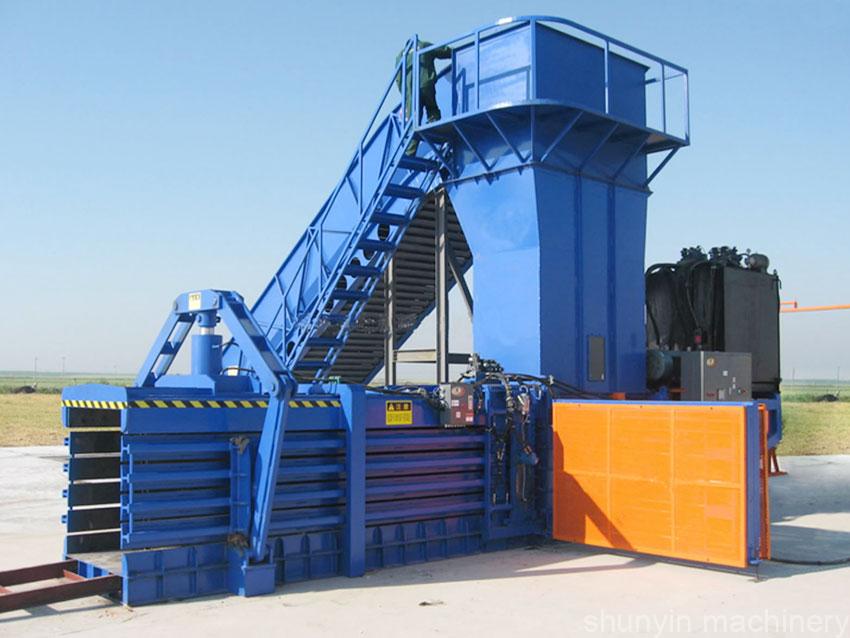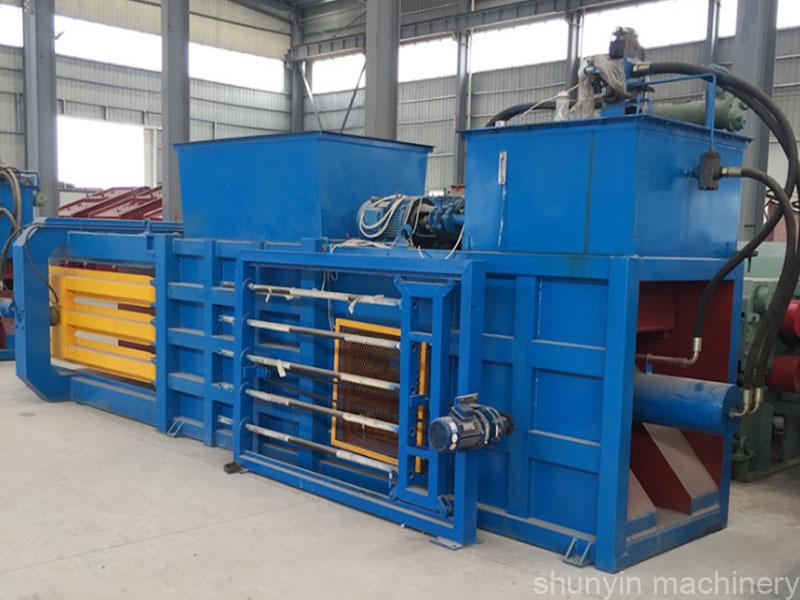
Cardboard waste accumulates quickly. Without the right baling machine, businesses face high disposal costs, inefficient recycling, and wasted storage space. A well-chosen baler transforms waste into a valuable resource.
To choose the best cardboard baler, consider your waste volume, available space, automation level, and cost. Follow these key steps:
-
Determine your waste volume
- Small (0-1 ton/day) → Vertical baler
- Medium (1-5 tons/day) → Semi-automatic horizontal baler
- Large (5+ tons/day) → Fully automatic horizontal baler
-
Assess available space
- Limited space? → Choose a compact vertical baler
- Large facility? → Opt for a horizontal baler with conveyor feeding
-
Decide automation level
- Manual → Hand-feeding & tying (low cost)
- Semi-automatic → Auto-ejects, manual tying
- Fully automatic → Continuous operation, auto-feeding & tying
-
Check compression power & bale size
- Higher compression force (30-100 tons) = denser bales
- Standard bale sizes ensure compatibility with recyclers
-
Prioritize safety & efficiency
- Safety features (emergency stops, safety locks)
- Energy-efficient models reduce costs
-
Compare costs & ROI
- Balance initial investment with long-term savings
- Potential revenue from selling compacted recyclables
Choosing the right cardboard baler increases efficiency, lowers waste costs, and improves recycling profits.
Selecting a cardboard baler requires careful planning. By understanding machine types, sizes, and recycling processes, businesses can make the best investment for long-term sustainability.
What machines are used to recycle cardboard?
Many businesses struggle to handle large amounts of cardboard waste. Without the right equipment, recycling becomes inefficient and costly.
The key machines used in cardboard recycling include balers, shredders, conveyors, and sorting systems. Balers compress cardboard into compact bales, making transportation and recycling easier, while shredders and conveyors streamline processing.

Essential Machines in the Cardboard Recycling Process
| Machine Type | Function | Benefit |
|---|---|---|
| Cardboard Baler | Compresses cardboard into bales | Reduces storage and transport costs |
| Shredder | Breaks down cardboard into small pieces | Speeds up pulping and recycling |
| Conveyor System | Moves materials to balers or shredders | Improves processing efficiency |
| Sorting Machine | Separates contaminants from cardboard | Ensures high recycling quality |
The Importance of Balers in Recycling
Balers play the most crucial role in the recycling process. By compressing loose cardboard, they create dense bales that are easier to transport and sell to recycling facilities. Without balers, businesses face excessive storage issues and increased transportation costs.
Manual vs. Automated Recycling Equipment
| Feature | Manual Equipment | Automated Equipment |
|---|---|---|
| Labor Requirement | High | Low |
| Processing Speed | Slow | Fast |
| Consistency | Inconsistent | Uniform bales |
Automated systems are ideal for large-scale operations, whereas smaller businesses can start with manual or semi-automatic balers.
What is a baler in recycling?
Many businesses rely on inefficient waste disposal methods, leading to high costs and environmental impact. A baler provides a structured solution.
A baler is a machine that compresses recyclable materials into dense bales for easy handling, storage, and transport. It optimizes waste management, reduces disposal costs, and increases recycling efficiency.

How a Baler Works
A baler uses hydraulic pressure to compress cardboard into compact bales. The process includes:
- Loading – Cardboard is placed into the baling chamber.
- Compression – The hydraulic press compresses the material into a dense shape.
- Tying – The bale is secured with metal wires or plastic straps.
- Ejection – The finished bale is removed and stored for transport.
Advantages of Using a Cardboard Baler
| Benefit | Impact |
|---|---|
| Space Efficiency | Frees up storage space by reducing cardboard volume |
| Lower Disposal Costs | Reduces waste hauling frequency |
| Higher Recycling Profits | Compressed bales have better resale value |
By investing in a baler, businesses can significantly reduce their waste management costs while increasing sustainability efforts.
What size cardboard baler do I need?
Choosing the wrong baler size leads to inefficiency. A small baler may not handle high waste volumes, while an oversized baler wastes energy and space.
The ideal baler size depends on the amount of cardboard waste generated daily. Businesses should select between small, mid-size, or large balers based on processing capacity and available space.

Choosing the Right Baler Based on Waste Output
| Daily Cardboard Waste | Recommended Baler Type |
|---|---|
| Under 1 ton | Small vertical baler |
| 1-5 tons | Mid-size vertical or horizontal baler |
| 5+ tons | Fully automatic horizontal baler |
Key Factors to Consider
- Available Space – Larger balers require more floor space.
- Labor Costs – Automated balers reduce manual handling time.
- Bale Weight – Heavier bales lower transportation costs.
Vertical vs. Horizontal Balers
| Factor | Vertical Baler | Horizontal Baler |
|---|---|---|
| Footprint | Compact | Large |
| Labor Requirement | Higher | Lower |
| Processing Speed | Slower | Faster |
Small businesses may benefit from vertical balers, while large recycling operations should invest in horizontal models for continuous processing.
How are cardboard bales recycled?
Many businesses bale cardboard but don’t understand what happens next. Knowing the recycling process ensures maximum value.
Cardboard bales go through a multi-step recycling process that includes collection, sorting, shredding, pulping, and remanufacturing into new paper products. This process reduces landfill waste and conserves natural resources.

Step-by-Step Cardboard Recycling Process
- Collection & Transportation – Baled cardboard is transported to a recycling facility.
- Sorting & Contaminant Removal – Plastic, tape, and other contaminants are removed.
- Shredding & Pulping – The cardboard is shredded and mixed with water to form a slurry.
- Screening & Refining – The pulp is cleaned to remove remaining impurities.
- Drying & Sheet Formation – The refined pulp is pressed and dried to create new cardboard sheets.
Environmental and Economic Benefits
| Benefit | Impact |
|---|---|
| Reduces Deforestation | Less demand for virgin paper materials |
| Lowers Waste Disposal Costs | Diverts waste from landfills |
| Supports Circular Economy | Helps businesses maintain sustainability goals |
Recycling cardboard bales benefits both the environment and businesses. Companies should ensure bales are clean and properly sorted to maximize their recycling value.
Conclusion
Choosing the right cardboard baler depends on waste volume, space availability, and processing needs. Investing in the correct machine improves recycling efficiency, lowers costs, and supports sustainability efforts.








